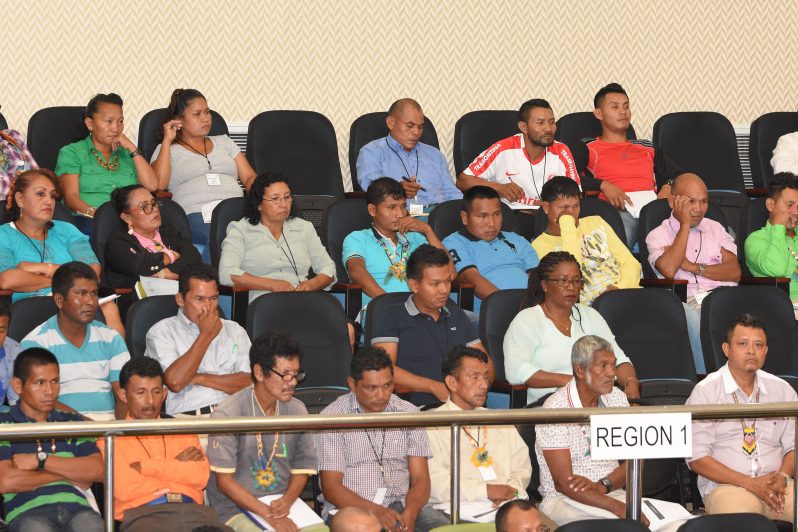…GL&SC calls for solutions-based dialogue

SEVERAL legal and procedural challenges and flaws are affecting the Guyana Lands and Surveys Commission (GL&SC) from effectively conducting its land titling exercises.
Manager of the Commission’s secretariat Durwin Humphrey told Toshaos from across the country Wednesday that there are many issues surrounding lands here, while adding that the existing issues are not new but have existed for decades.
“One example of that is when a village is being titled what has been practiced is issuing an absolute grant and including a clause called the ‘save and except clause’. This creates a legal problem and a legal loophole, so what we have been advocating for is for proper investigations to be conducted prior to demarcation,” he explained.
Humphrey’s comments followed a number of concerns raised by Toshaos at the 12th Annual National Toshaos Council (NTC) Conference being held at the Arthur Chung Conference Centre, Liliendaal, Greater Georgetown. He made it clear that there are lots of legislation which are relevant to Amerindian Land titling and those legislation must be followed.
“We have to have serious solutions-based dialogue. The Amerindian Act of 2006 and State Lands acts – they are competing, so there are issues where the Acts come together. There needs to be some sort of legislative cohesion which allows for the smooth and timely processing of titles,” Humphrey added while agreeing that there needs to be “lasting solutions.”
He did not deny the challenges faced by the Indigenous communities across the country as it relates to demarcation and land titling and declared that “the Commission is interested in ensuring that Amerindian land titles take place with the type of urgency that is required.”
Speaking with reporters after his brief presentation, the Manager of the Commission’s secretariat reiterated that there remains several procedural and legal issues as it relates to Amerindian land titling which have to be ironed out. He stressed the need for “proper investigations” to be carried out prior to demarcation exercises.
This has been a constant complaint by the indigenous peoples. “The system is an imperfect one. We have an amalgamation of the Amerindian Act of 2006 and we have a reference made to the State Lands Act under which title is granted and together with that we have references to Acts like the Survey Special Provisions Act which creates some issues as it relates to demarcation of lands prior to the issuance of a title,” He explained.
Humphrey accepted that an investigation has to be launched in several communities including Santa Rosa, located in Region 1, as it relates to demarcation issues and the exclusion of communities. Such issues were raised by Sharon Atkinson, of the said village. “What we have been seeing more and more of is these issues where there were not proper investigations conducted, not through the fault of the Guyana Lands and Surveys Commission, but basically because of an imperfection in the system that has been put in place,” the Manager stated while making it clear the issues affecting Santa Rosa Village also affect other communities.
He suggested that in order to fix what he described as an “imperfect system” there may need to be a revision of the law. Humphrey disclosed that legislative review is being looked at by his Commission. He said the review is not particularly targeting the Amerindian Act but laws related to land and land governance.
Additionally, Humphrey told reporters that another solution could be a Lands Commission of Inquiry. “I think that still is something that is on the table and I am not going to speak too much on that but I think we are starting where we can start, with a review of the legislation and we can put forward recommendations as to how things can improve,” he told Guyana Chronicle.
While there has been little improvement in some areas, much work is yet to be done and according to GL&SC’s Manager, his office will be working with a few villages this year to resolve some outstanding matters.
“Conflict has plagued this entire situation for quite some time and we are not willing to support or countenance something like that,” he stated.
When asked whether his entity has the requisite human resources to adequately address the issues raised by the Toshaos, Humphrey said, “The issue is not the ‘people power’ as you are aware, land titling is an expensive activity and we are always ready and available to conduct land titling. We have a few villages which we will be addressing this year and so the issue is not our capacity.” He made it clear that the issue is more a legal and procedural one rather than one of lack of capacity.
Slothfulness
Meanwhile, after the GL&SC presentation which lasted approximately 20 minutes, Toshao of Orealla, David Henry, questioned the slothfulness of the entity in addressing issues facing his community. Henry explained that Orealla has had boundary issues since 2015 and from then to now, the village’s logging operations has been affected.
“GFC has a map different from what exists. Our boundary was established some 30 years ago—concrete polls are there- the GFC map is not reflecting what is on the ground. There is an overlapping situation,” the Toshao stated while calling for a “speedy solution to this”.
“I can’t see why any commission in Guyana must be so slow. Our communities are stagnated because of this sort of situations. These conferences must not be just for the sake of having a conference, we want our issues to be resolved and very quickly,” the frustrated Toshao stated.
Similarly, Sharon Atkinson of Santa Rosa Village, remarked that the legislation governing Amerindian lands is 150 years old. She noted that the recent demarcations conducted across Region 1, particularly in the Moruca Sub-Region, has left many dissatisfied and excluded. “We have reports from various villages with overlaps, farmlands, camp sites, homes; in some cases people have become technically squatters…there needs to be an investigation. There is very flawed feedback on investigation; the majority of villages are feeling very insecure about their land tenure situation,” Atkinson declared.
She told the GL&SC that people are fed up of the situation. “We have been waiting and we are tired of waiting on, I think we have reached the extreme patient limit to have these issues resolved,” the frustrated woman said as she called for consultations among stakeholders.
Touch base with us
Nicholas Frederick, Toshao of Shulinab village, Region 9 and newly elected Chairman of the NTC cautioned the GL&SC against entering villages in the South Rupununi to conduct surveys without informing the relevant village councils. “We would like to recommend that you please touch base with the village councils informing them of the activities you are going to do and the locations. Just a matter of protocol–we need to strengthen our communication system,” said Fredericks.
Russian Dorrick, Toshao of Yupakari, Region 9, called on the Commission to process applications for land extensions speedily. “It takes a lot of time and yet there are more land leases given to major developments when we have already requested for this land,” he said while recommending that the NTC and GL&SC work closely with the Ministry of Indigenous People’s Affairs, the GGMC and the Guyana Forestry Commission.
Former Vice-Chairman of the NTC, Lenox Shuman, opined that the Commission has made a “disingenuous effort” to address land issues affecting the indigenous population. “My recommendation is that the incoming executive is given an opportunity and enough funding to engage GL&SC in seeking the way forward.” In response, Humphrey made it clear that the GL&SC has a “highly consultative” process in place which involves villages and neighbouring villages. “There are prior meetings that take place and the Ministry of Indigenous People’s Affairs meet on this, minutes of the meeting are kept and agreements are signed. I am not sure where the issues are arising, but where they arise we have undertaken to address them,” Humphrey committed.



.jpg)








